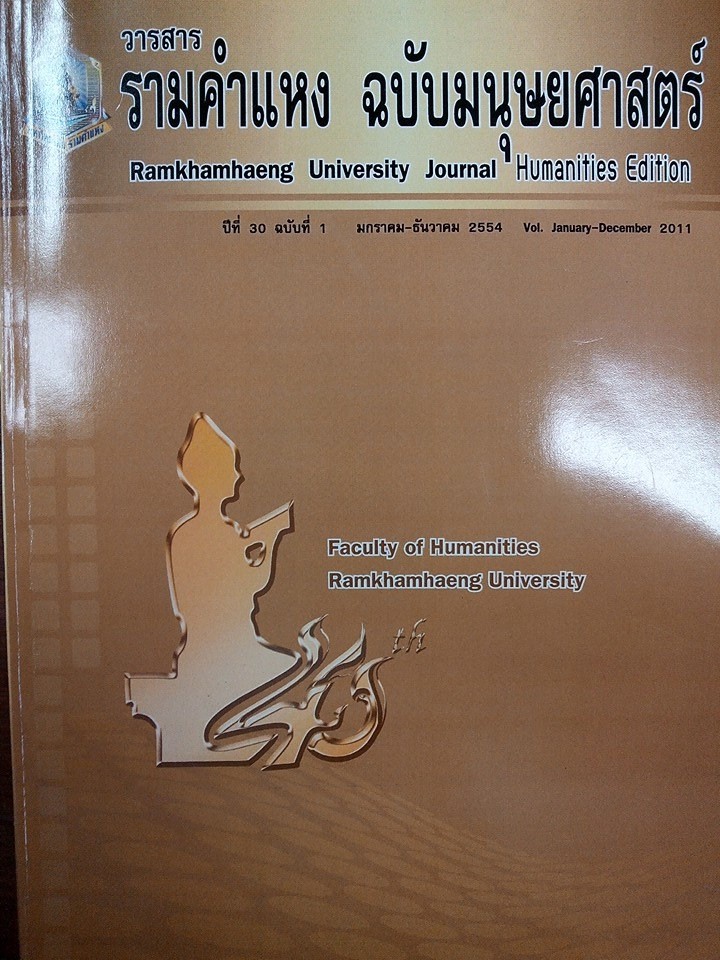ความชอบสีภายใต้สภาวะการปรากฏสีที่แตกต่าง Color Preference Observed under Different Color Appearance Mode
Main Article Content
บทคัดย่อ
ABSTRACT
Color is one of the critical factors influencing customersY satisfaction; an understanding of color preference is thus important in many fields. Most often when we are choosing a color we have in mind of an object that we want in that color, either paint for a room, a certain piece of clothing, or a ripe fruit in the store. Thus, when we are expressing our color preference, it is usually of an object color. But, there are other modes of appearance such as colored lights. How do these relate to our color preference? In a phenomenological approach, there are plenty of color appearance modes in our daily life. What do we know about color preferences among different
color appearance modes? Let us suppose the case of a mobile phone display on which a color is observed in daylight and at night. The color appears as a reflecting surface in daylight, whereas it appears to radiate on its own at night. Is there consistency in color preference between daytime
and nighttime? Furthermore, although the color preference models have been released, the existing models are suitable for colors appearing in the object color mode only. The models based on the CIELAB system, for instance, could not predict color preference if the color appearance mode of a color changes to other modes but the colorimetric values of that color
sample under different color appearance modes do not change. Based on the perceived color attributes, a method for quantitatively predicting color preference was exhibited as a practical application tool for designers.
Color is one of the critical factors influencing customersY satisfaction; an understanding of color preference is thus important in many fields. Most often when we are choosing a color we have in mind of an object that we want in that color, either paint for a room, a certain piece of clothing, or a ripe fruit in the store. Thus, when we are expressing our color preference, it is usually of an object color. But, there are other modes of appearance such as colored lights. How do these relate to our color preference? In a phenomenological approach, there are plenty of color appearance modes in our daily life. What do we know about color preferences among different
color appearance modes? Let us suppose the case of a mobile phone display on which a color is observed in daylight and at night. The color appears as a reflecting surface in daylight, whereas it appears to radiate on its own at night. Is there consistency in color preference between daytime
and nighttime? Furthermore, although the color preference models have been released, the existing models are suitable for colors appearing in the object color mode only. The models based on the CIELAB system, for instance, could not predict color preference if the color appearance mode of a color changes to other modes but the colorimetric values of that color
sample under different color appearance modes do not change. Based on the perceived color attributes, a method for quantitatively predicting color preference was exhibited as a practical application tool for designers.
Article Details
รูปแบบการอ้างอิง
ตั้งกิจวิวัฒน์ ด. (2014). ความชอบสีภายใต้สภาวะการปรากฏสีที่แตกต่าง Color Preference Observed under Different Color Appearance Mode. วารสารรามคำแหง ฉบับมนุษยศาสตร์, 30(1), 152–165. สืบค้น จาก https://so05.tci-thaijo.org/index.php/huru/article/view/27888
ประเภทบทความ
บทความวิชาการ

อนุญาตภายใต้เงื่อนไข Creative Commons Attribution-NonCommercial-NoDerivatives 4.0 International License.
ประกาศลิขสิทธิ์จะปรากฏในเกี่ยวกับวารสาร ควรอธิบายสำหรับผู้อ่านและผู้เขียนว่าเจ้าของลิขสิทธิ์เป็นผู้เขียนวารสารหรือบุคคลที่สาม ควรรวมถึงข้อตกลงการอนุญาตเพิ่มเติม (เช่นใบอนุญาตครีเอทีฟคอมมอนส์) ที่ให้สิทธิ์แก่ผู้อ่าน (ดูตัวอย่าง) และควรให้วิธีการรักษาความปลอดภัยหากจำเป็นสำหรับการใช้เนื้อหาของวารสาร


